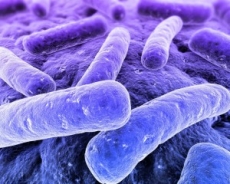 La listeria desarrolla resistencia a los desinfectantes - versión en Inglés. La listeria desarrolla resistencia a los desinfectantes - versión en Inglés.
Listeriosis is a foodborne illness caused by Listeria monocytogenes, bacteria found in soil and water. It can be in a variety of raw foods as well as in processed foods and foods made from unpasteurized milk. Listeria is unlike many other germs because it can grow even in the cold temperature of the refrigerator. Listeria poses a significant risk to human health. Listeriosis affects mainly pregnant women, newborns, the elderly, and adults with impaired immune systems. Healthy adults and children sometimes are infected with L. monocytogenes, but they rarely become seriously ill. Babies can be born with listeriosis if their mothers eat contaminated food during pregnancy.
The main transmission route involves meat and dairy products, so it is important to treat dairies and food-processing plants regularly with disinfectants to kill bacteria. Unfortunately, listeria is developing resistance to the compounds that are most frequently used. Recent work in the group of Stephan Schmitz-Esser at the University of Veterinary Medicine, Vienna (Vetmeduni Vienna) has uncovered the mechanism for listeriaâs resistance to one such agent, benzalkonium chloride.
Recent years have seen significant outbreaks of listeriosis on both sides of the Atlantic. Although the disease can usually be treated successfully, it is occasionally fatal, most frequently in pregnant women or immunocompromized people. And even when treatment is effective, the symptoms are anything but pleasant and include fever and muscle aches along with diarrhoea and other gastrointestinal symptoms. The old adage is clearly true: prevention is better than cure.
Prevention of listeriosis relies on killing the causative agent, normally the bacterium Listeria monocytogenes, in dairies and other food-processing facilities. A number of disinfectants are used for this purpose, most often quaternary ammonium compounds such as benzalkonium chloride (BC). Unfortunately, however, many strains of listeria seem to be developing resistance to these agents, although the underlying mechanisms have remained obscure. Together with colleagues in Ireland, the group of Stephan Schmitz-Esser of the Vetmeduniâs Institute for Milk Hygiene has provided convincing evidence that a novel piece of DNA in the bacteria is involved.
The scientists used next-generation sequencing techniques to determine the DNA sequences of two strains of listeria known to be resistant to BC. When they examined the sequences they noticed a region of DNA of ca. 5 kb that was strikingly different in composition from the remainder of the genome. The bacteria seem to have acquired this novel element fairly recently and Schmitz-Esser termed it Tn6188 (so-called transposons are frequent in bacterial genomes, explaining the high number).
Of course, the presence of Tn6188 in two strains resistant to BC might merely be a coincidence. The researchers thus screened an additional 90 strains of listeria for the element, finding it in ten of them. The ten strains harbouring Tn6188 turned out to be far less sensitive to benzalkonium chloride. One of the five proteins that could be encoded by Tn6188, termed QacH by Schmitz-Esser and colleagues term because of its similarity to proteins of this name from other organisms, was activated by the presence of BC in culture medium. And in a final experiment, the scientists could show that deleting the QacH gene made listeria once again sensitive to the drug.
Although his group has not formally proved that the new transposon is responsible for BC resistance in listeria, Schmitz-Esser feels that he has âprobably sufficient circumstantial evidence to obtain a conviction. In any case our results show that listeria can acquire new genetic material from other bacteria â it is thus important to ensure thorough disinfecting of food-processing facilities to prevent reservoirs of resistant bacteria building up and transferring their resistance to listeria.â
| 